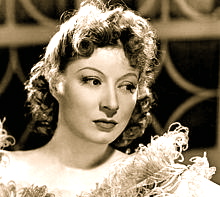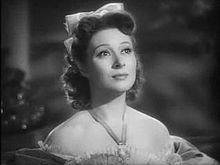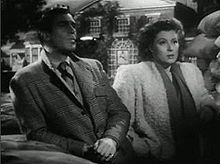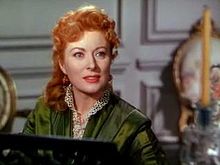Greer Garson

Goodbye Mr. Chips 1939 Official Trailer (Nominated Oscar / Best Picture)
An aged teacher and former headmaster of a boarding school recalls his career and his personal life over the decades. Director: Sam Wood, and 1 more credit, Writers: R.C. Sherriff (screen play), Claudine West (screen play), and 2 more credits. Stars: Robert Donat, Greer Garson and Terry Kilburn.
 Eileen Evelyn Greer Garson, CBE (29 September 1904 – 6 April 1996) was a British actress who was very popular during World War II, being listed by the Motion Picture Herald as one of America’s top ten box office draws in 1942–46. As one of MGM‘s major stars of the 1940s, Garson received seven Academy Award nominations, winning the Best Actress award for Mrs. Miniver (1942).
Eileen Evelyn Greer Garson, CBE (29 September 1904 – 6 April 1996) was a British actress who was very popular during World War II, being listed by the Motion Picture Herald as one of America’s top ten box office draws in 1942–46. As one of MGM‘s major stars of the 1940s, Garson received seven Academy Award nominations, winning the Best Actress award for Mrs. Miniver (1942).
Early life
Born in Manor Park, Essex, England in 1904, the only child of George Garson (1865–1906), a clerk born in London, but with Scottish lineage, and his wife, Nina (née Nancy Sophia Greer; died 1958). (The name “Greer” is a contraction of “MacGregor,” another family name.) Her maternal grandfather was David Greer, a RIC sergeant in Castlewellan, County Down, Ireland in the 1880’s and who later became a land steward to the Annesley family (wealthy landlords who built the town of Castlewellan). He lived in a large detached house built on the lower part of what was known as Pig Street or known locally as the Back Way near Shilliday’s builder’s yard. The house was called ‘Claremount’ and today the street is named Claremount Avenue. It was often reported that Garson was born in this house. She was, in fact, born in London, but spent much of her childhood in Castlewellan.
Education
She was educated at King’s College London, where she earned degrees in French and 18th century literature, and at the University of Grenoble in France. She had intended to become a teacher, but instead began working with an advertising agency, and appeared in local theatrical productions.
Career
Greer Garson’s early professional appearances were on stage, starting at Birmingham Repertory Theatre in January 1932. She appeared on television during its earliest years (the late 1930s), most notably starring in a thirty-minute production of an excerpt of Twelfth Night in May 1937, with Dorothy Black. These live transmissions were part of the BBC‘s experimental service from Alexandra Palace and this is the first known instance of a Shakespeare play performed on television.
 Garson in Pride and Prejudice (1940)
Garson in Pride and Prejudice (1940)
Louis B. Mayer discovered Garson while he was in London looking for new talent. Garson was signed to a contract with MGM in late 1937, but did not begin work on her first film, Goodbye, Mr. Chips, until late 1938. She received her first Oscar nomination for the role, but lost to Vivien Leigh for Gone with the Wind. She received critical acclaim the next year for her role as Elizabeth Bennet in the 1940 film, Pride and Prejudice.
Garson starred with Joan Crawford in When Ladies Meet in 1941, and that same year became a major box office star with the sentimental Technicolor drama, Blossoms in the Dust, which brought her the first of five consecutive Best Actress Oscar nominations, tying Bette Davis‘ 1938–42 record, a record that still stands. Garson won the Academy Award for Best Actress in 1942 for her role as a strong British wife and mother in the middle of World War II in Mrs. Miniver. (Guinness Book of World Records credits her with the longest Oscar acceptance speech, at five minutes and 30 seconds, after which the Academy Awards instituted a time limit.) She was also nominated for Madame Curie (1943), Mrs. Parkington (1944), and The Valley of Decision (1945).
Garson was a frequent costar of Walter Pidgeon, ultimately making eight pictures with him: Blossoms in the Dust (1941), Mrs. Miniver (1942), Madame Curie , Mrs. Parkington, Julia Misbehaves (1948), That Forsyte Woman (1949), The Miniver Story (1950), and Scandal at Scourie (1953).
 Garson and co-star Walter Pidgeon in The Miniver Story (1950)
Garson and co-star Walter Pidgeon in The Miniver Story (1950)
Garson was partnered with Clark Gable, after his return from war service, in Adventure (1945). The film was advertised with the catch-phrase “Gable’s back and Garson’s got him!” Gable argued for “He put the Arson in Garson;” she countered “She put the Able in Gable!”; thereafter, the safer catchphrase was selected. Garson’s popularity dropped somewhat in the late 1940s, but she remained a prominent film star until the mid-1950’s.
In 1951, she became a naturalised citizen of the United States. She made only a few films after her MGM contract expired in 1954. In 1958, she received a warm reception on Broadway in Auntie Mame, replacing Rosalind Russell, who had gone to Hollywood to make the film version. In 1960, Garson received her seventh and final Oscar nomination for Sunrise at Campobello, in which she played Eleanor Roosevelt, this time losing to Elizabeth Taylor for Butterfield 8. Greer was special guest on an episode of the TV series Father Knows Best, playing herself.
Goodbye Mr. Chips
On 4 October 1956, Garson appeared with Reginald Gardiner as the first two guest stars in the series premiere of NBC‘s The Ford Show, Starring Tennessee Ernie Ford.
Garson appeared as a mystery guest on What’s My Line on 6 April 1958. She stumped the panel. She also appeared in Laugh-in showing her comic side.
Garson’s last film, in 1967, was Walt Disney‘s The Happiest Millionaire, although she made infrequent television appearances afterwards. In 1968, she narrated the children’s television special The Little Drummer Boy, which continues to be aired on ABC Family. Also during this time, she also appeared in Laugh-in and the Smothers Brothers Comedy Hour showing her great sense of humor.
Personal life
Garson was married three times. Her first marriage, on 28 September 1933, was to Edward Alec Abbot Snelson (1904–1992), later Sir Edward, a British civil servant who became a noted judge and expert in Indian affairs. The actual marriage reportedly lasted only a few weeks, but it was not formally dissolved until 1943.
Her second husband, whom she married (at age 39) on 24 Jul 1943, was Richard Ney (1916–2004), the younger actor (27 years old) who played her son in Mrs. Miniver. They divorced in 1947. Ney claimed the divorce was due to the pressure of sharing a home with his mother-in-law, while Garson testified in court that Ney was critical of her work and accused her of being a “has-been.” Ney eventually became a respected stock market analyst, financial consultant, and author.
In 1949, she married a millionaire Texas oilman and horse breeder, E.E. “Buddy” Fogelson (1900–1987), and in 1967, the couple retired to their “Forked Lightning Ranch” in New Mexico. They purchased the U.S. Hall of Fame champion Thoroughbred Ack Ack from the estate of Harry F. Guggenheim in 1971 and were highly successful as breeders. They also maintained a home in Dallas, Texas, where Garson funded the Greer Garson Theatre facility at Southern Methodist University.
Garson donated millions for the construction of the Greer Garson Theatre at both the Santa Fe University of Art and Design and at Southern Methodist University’s Meadows School of the Arts on three conditions: 1) the stages be circular, 2) the premiere production be William Shakespeare‘s A Midsummer Night’s Dream, and 3) they have large ladies’ rooms.
Garson was a devout Presbyterian.
Death
Greer Garson died from heart failure at Presbyterian Hospital in Dallas on 6 April 1996 at the age of 91. She is interred beside her husband in the Sparkman-Hillcrest Memorial Park Cemetery in Dallas.



